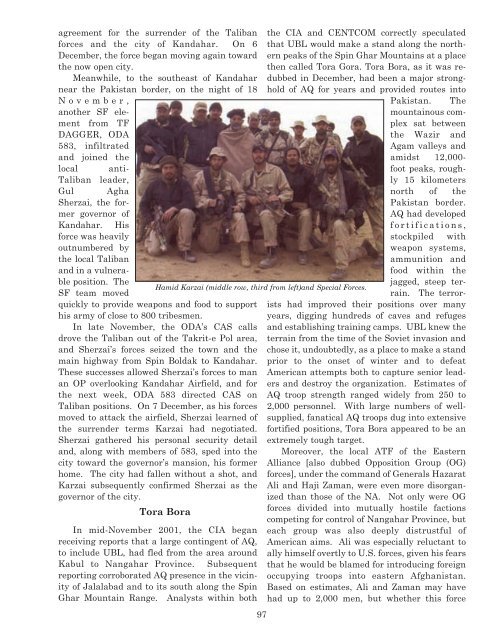HQ$History - United States Special Operations Command
HQ$History - United States Special Operations Command
HQ$History - United States Special Operations Command
Create successful ePaper yourself
Turn your PDF publications into a flip-book with our unique Google optimized e-Paper software.
agreement for the surrender of the Taliban<br />
forces and the city of Kandahar. On 6<br />
December, the force began moving again toward<br />
the now open city.<br />
Meanwhile, to the southeast of Kandahar<br />
near the Pakistan border, on the night of 18<br />
N o v e m b e r ,<br />
another SF element<br />
from TF<br />
DAGGER, ODA<br />
583, infiltrated<br />
and joined the<br />
local anti-<br />
Taliban leader,<br />
Gul Agha<br />
Sherzai, the former<br />
governor of<br />
Kandahar. His<br />
force was heavily<br />
outnumbered by<br />
the local Taliban<br />
and in a vulnerable<br />
position. The<br />
SF team moved<br />
quickly to provide weapons and food to support<br />
his army of close to 800 tribesmen.<br />
In late November, the ODA’s CAS calls<br />
drove the Taliban out of the Takrit-e Pol area,<br />
and Sherzai’s forces seized the town and the<br />
main highway from Spin Boldak to Kandahar.<br />
These successes allowed Sherzai’s forces to man<br />
an OP overlooking Kandahar Airfield, and for<br />
the next week, ODA 583 directed CAS on<br />
Taliban positions. On 7 December, as his forces<br />
moved to attack the airfield, Sherzai learned of<br />
the surrender terms Karzai had negotiated.<br />
Sherzai gathered his personal security detail<br />
and, along with members of 583, sped into the<br />
city toward the governor’s mansion, his former<br />
home. The city had fallen without a shot, and<br />
Karzai subsequently confirmed Sherzai as the<br />
governor of the city.<br />
Tora Bora<br />
In mid-November 2001, the CIA began<br />
receiving reports that a large contingent of AQ,<br />
to include UBL, had fled from the area around<br />
Kabul to Nangahar Province. Subsequent<br />
reporting corroborated AQ presence in the vicinity<br />
of Jalalabad and to its south along the Spin<br />
Ghar Mountain Range. Analysts within both<br />
97<br />
the CIA and CENTCOM correctly speculated<br />
that UBL would make a stand along the northern<br />
peaks of the Spin Ghar Mountains at a place<br />
then called Tora Gora. Tora Bora, as it was redubbed<br />
in December, had been a major stronghold<br />
of AQ for years and provided routes into<br />
Pakistan. The<br />
mountainous complex<br />
sat between<br />
the Wazir and<br />
Agam valleys and<br />
amidst 12,000-<br />
foot peaks, roughly<br />
15 kilometers<br />
north of the<br />
Pakistan border.<br />
AQ had developed<br />
f o r t i f i c a t i o n s ,<br />
stockpiled with<br />
weapon systems,<br />
ammunition and<br />
food within the<br />
jagged, steep terrain.<br />
The terrorists<br />
had improved their positions over many<br />
years, digging hundreds of caves and refuges<br />
and establishing training camps. UBL knew the<br />
terrain from the time of the Soviet invasion and<br />
chose it, undoubtedly, as a place to make a stand<br />
prior to the onset of winter and to defeat<br />
American attempts both to capture senior leaders<br />
and destroy the organization. Estimates of<br />
AQ troop strength ranged widely from 250 to<br />
2,000 personnel. With large numbers of wellsupplied,<br />
fanatical AQ troops dug into extensive<br />
fortified positions, Tora Bora appeared to be an<br />
extremely tough target.<br />
Moreover, the local ATF of the Eastern<br />
Alliance [also dubbed Opposition Group (OG)<br />
forces], under the command of Generals Hazarat<br />
Ali and Haji Zaman, were even more disorganized<br />
than those of the NA. Not only were OG<br />
forces divided into mutually hostile factions<br />
competing for control of Nangahar Province, but<br />
each group was also deeply distrustful of<br />
American aims. Ali was especially reluctant to<br />
ally himself overtly to U.S. forces, given his fears<br />
that he would be blamed for introducing foreign<br />
occupying troops into eastern Afghanistan.<br />
Based on estimates, Ali and Zaman may have<br />
had up to 2,000 men, but whether this force<br />
Hamid Karzai (middle row, third from left)and <strong>Special</strong> Forces.

















